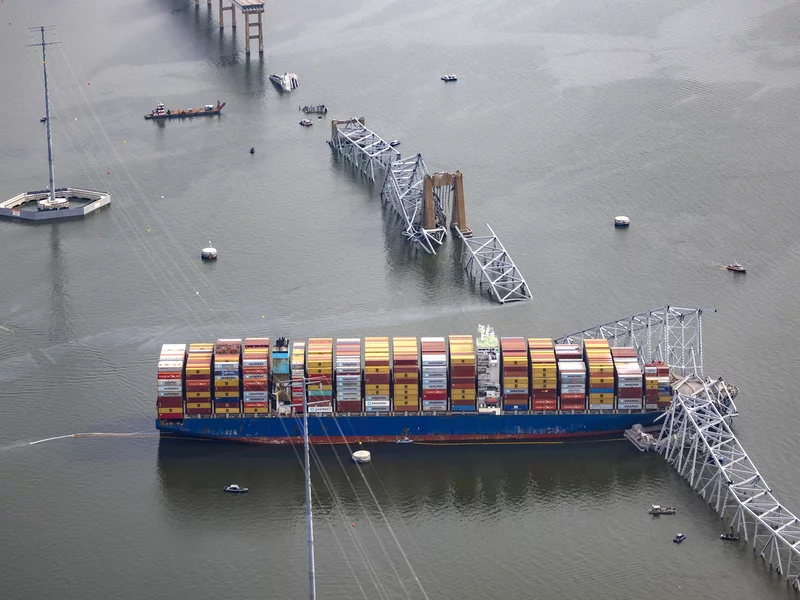Blog
Baltimore’s Francis Scott Key bridge collapses after large cargo ship collision.
Before its devastating collapse on March 26, 2024, the Francis Scott Key Bridge was an economically critical gateway: thousands of container ships passing from the Atlantic to Baltimore’s port passed beneath the bridge’s decades-long span.

However, the now-demolished building is not the only bridge along that important maritime route: the Chesapeake Bay Bridge near Annapolis, located 20 miles downstream, is also used by big container ships bound for Baltimore. Furthermore, experts who evaluated its design believe it may collapse if one of those vessels collided with it.
What Did History Say About The Key Bridge?
When the Key Bridge opened in 1977, cargo ships passing through the Port of Baltimore were smaller and lighter than today’s. The dolphins, which were placed shortly after the bridge was completed, saved it at least once. In 1980, a ship collided with a dolphin, damaging it but sparing the bridge.
Since then, the size of cargo ships has increased. The Key Bridge and its dolphins can now support up to ten times more weight and extend nearly twice as far as before. The American Association of State Highway and Transportation Officials, which sets standards for bridge building safety, mandates newer bridges to have strong collision prevention features. Many ports have these.
Key Bridge: Experts Say Safety Measures Lacking
Several of the four-mile-long Bay Bridge’s concrete piers, which sit in the middle of the shipping channel, are vulnerable to the same type of ship accident that destroyed the Key Bridge, according to experts.
The bridge is “lacking in safety measures,” according to Adel ElSafty, an engineering professor at the University of North Florida, who believes the structure should be reviewed in light of the Key Bridge disaster. “It could very much be vulnerable to a ship impact.”
Eonline360 examined the defensive design characteristics of over a dozen key US bridges that cross shipping channels to the country’s largest ports. According to remarks from local officials and conversations with more than a half-dozen structural engineering specialists, most feature greater anti-ship crash defences than the Key Bridge, such as more robust fender systems or larger concrete structures designed to deflect incoming vessels.
According to experts, a handful of other bridges, notably the Chesapeake Bay Bridge, have less robust defences, potentially putting them at risk as increasingly massive container ships pass beneath them.
According to federal data, the majority of the bridges, including the Key Bridge, have “fracture critical members,” which means that if one element is removed, the entire system may collapse. The Key Bridge collapsed when the ship took off one of its vertical support piers, and it would have fallen even without fracture-critical elements, according to Matthew Yarnold, an engineering professor at Auburn University.
About The Crew Member After Fall Down Of Key Bridge
Nearly a week after Baltimore’s francis scott key memorial bridge collapsed, almost two dozen sailors remain stranded on-board the vessel involved in the accident. Most of the crew of the Dali, a 948ft (289m) container ship, are from India. One was slightly injured when the ship collided with the bridge.
Six people were killed in the collapse. Investigators are working to determine exactly what caused the collision, and it is unclear when the crew will be able to leave the vessel. Here’s what we know about the men on-board the Dali and their current situation.
In total, 21 crew members were on-board the Dali at the time of the accident, which happened just minutes into the ship’s 27-day journey to Sri Lanka. India has confirmed that 20 of them are Indian citizens. Government statistics show that 315,000 Indians are employed in the global maritime industry, about 20% of the total. Indians are second only to Filipinos in the sector.
One crew member is from Sri Lanka, according to the US Coast Guard. An Indian official said last week the crew are all in good health, including the one member with a minor injury, which required stitches. Now all are rescued and safe.
In short, We believe that the procedures we currently have in place are more than capable of handling any form of mishap that may occur, but we are not complacent,” Hanson stated. “The community owns the bridges, and we hold them in trust on their behalf. It’s our responsibility to pass them on to the next generation in better form than we received them.
The collapse of the Key Bridge is a significant concern due to its age and status as a major bridge in the US. Those responsible for any negligence leading to this incident should be held accountable under the law. Whether it’s a maintenance issue or engineering oversight, those responsible for the bridge’s upkeep must be held accountable.